Exclusive Windows 11 Survey: what consumers really think about the future
Here are the top five takeaways from our just-completed Windows 11 survey:
- Windows 7 users are thrilled about the new OS, with 65% willing to finally upgrade
- A third of users are actually expecting Microsoft to release a full, separate version of Windows
- Half of polled readers want a fast interface and a design overhaul
- Losing data while upgrading is a big fear factor, with 9% of users refusing to upgrade because of that possibility
- Windows 11 might bring a boom in sales, as 8% of users are willing to buy a new device to upgrade

The following research has been compiled from the opinions of 6056 readers who completed our opt-in online survey over the course of seven days. Almost 32% of answers were recorded from the USA, while the next most popular countries were India, the United Kingdom, Canada, and Australia. Their unaltered answers are presented below.
Microsoft is one of the biggest companies around, and their products are backed up by decades of experience and a great variety of different services meant to increase productivity and usability. From collaboration tools and cloud services to useful apps and programs, and even gaming and quality hardware, the Redmond giant continuously seeks to offer a complete and satisfying computing experience.
Undoubtedly, one of Microsoft’s biggest assets is its operating system, Windows. If Windows 95, 98, and NT were only the first steps, Windows XP and Vista had a lot more to offer in terms of design, usability, and practicality. This evolution continued with Windows 8 and 8.1. They were modest successes at best. Overall, however, the biggest improvement came with the introduction of Windows 10 in 2014.
After a few questionable design decisions with Windows 8, its replacement (Windows 10), included many new changes and improvements tailored specifically for usability and security. Windows 10’s indisputable improvements upon the company’s previous operating systems is confirmed through a sizable increase in the number of monthly active Windows 10 devices, which Microsoft reported as more than 1.3 B billion in April 2021.
This increase was less obvious in the first few months after Windows 10’s initial release. Over time, its growth and acceptance became much clearer, once the OS had time to mature, stabilize and improve with each new upgrade.
Despite all these things, many Windows users remain reluctant to upgrade to Windows 10. Most often, their hesitancy is related to design, functionality, or security. But the tech giant decided to address them all through a brand-new release of Windows 11.
Continuing the legacy of Windows 10, Windows 11 seeks to solve all previous problems and also improve user experience based upon feedback from dedicated Windows Insiders. This new OS version is built upon the backbone of the previous one, but also brings massive changes crafted in response to users’ thoughts, suggestions and opinions obtained through the Windows 10 Feedback Hub.
We, at WindowsReport, value your opinion above all else. With that in mind, we decided to make a thorough study based 100% on reader input. After gathering information from Windows users in multiple countries, on multiple platforms, using different operating systems, we’ve arrived at a number of interesting conclusions.
Our results reflect peoples’ unfiltered and unbiased opinion about Microsoft’s latest operating system. They’re based on real answers from real people who shared their time and thoughts with us. Without further ado, let’s see those results!
Almost a fourth of users haven’t heard of the upcoming update
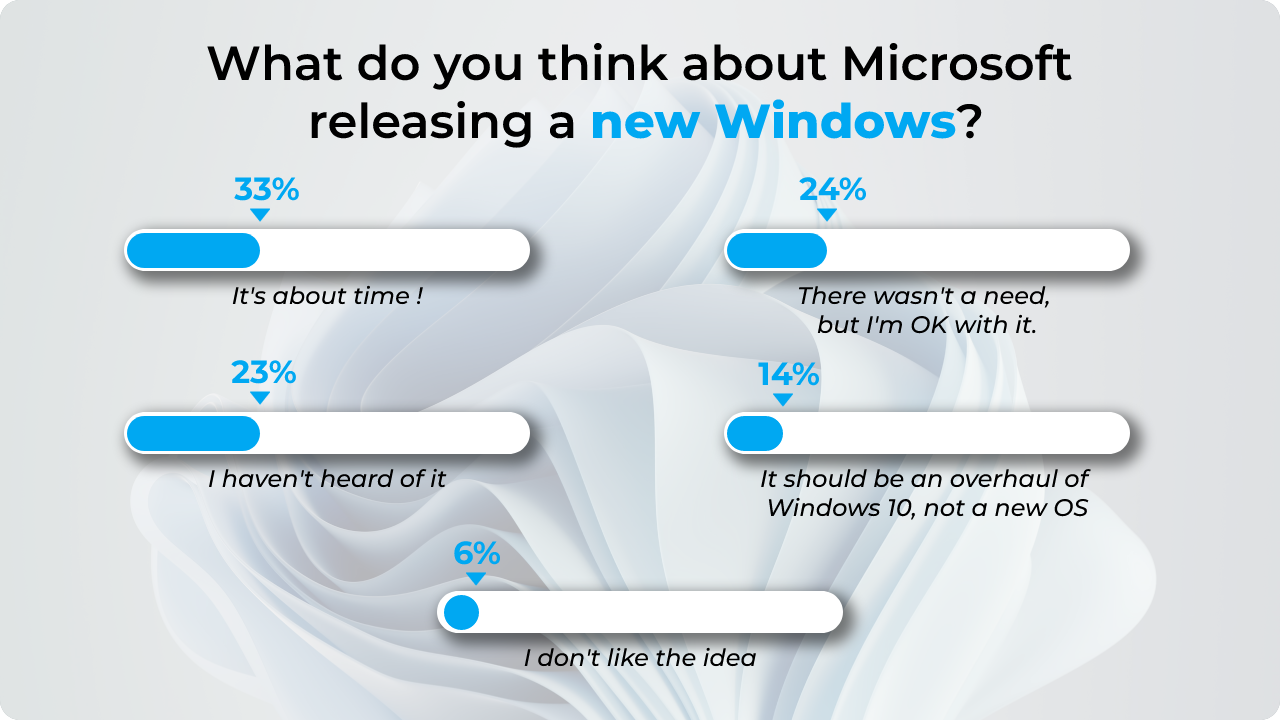
While Microsoft’s latest operating system was leaked weeks before its official debut, it seems that many people remain un-aware of the upcoming upgrade. According to our study, 23% of respondents had no idea that a new OS will soon likely replace Windows 10.
This new addition to the Windows family wasn’t too obvious even to experienced users. That’s in part because when Microsoft released Windows 10, a company spokesperson stated that it would be their last release of a new OS. With that in mind, all future changes and improvements come in the form of monthly/quarterly updates and semi-annual upgrades.
This is further backed up by 14% of respondents who think that Windows 11 should just be an overhaul of Windows 10 rather than a new and separate OS. Microsoft’s choice in this case is understandable, after its experiences with Windows 8 and Windows 8.1.
If Windows 8 brought obvious new changes and improvements, Windows 8.1’s innovations were easily overlooked and had only minimum impact on the user experience. Thus, the decision to introduce a fresh new OS based on Windows 10 feedback is a logical outcome.
If you’re in the same boat, unaware of Microsoft’s next OS, be sure to follow our full and in-depth coverage. We’ll be sure to keep you updated with all the latest info and developments.
33% of users were waiting for a new OS instead of an update to Windows 10
Despite prevailing sentiments, one third of our respondents want a new operating system. This is a big number, considering that most of the Windows community is pretty hesitant when it comes to new versions.
Recent history shows us that users, in general, saw Windows 10 as a mild upgrade from Windows 8. Based on a higher than usual market share for Windows 7 and Windows 8, many of them chose to stick with their current OSes instead of upgrading to the latest version.
This might be a good sign for next-in-line OS Windows 11, with more users upgrading after its official release. For now, the main reasons people say they want to upgrade include the design overhaul, a faster interface, improved security and a significant performance boost for gaming.
Another interesting conclusion from our research is that only 6% of those who answered our questions don’t like the idea of a completely new operating system. This fuels the general belief that for once, a new version of Windows might appeal to the majority of users.
What’s the name of Microsoft’s newest OS?
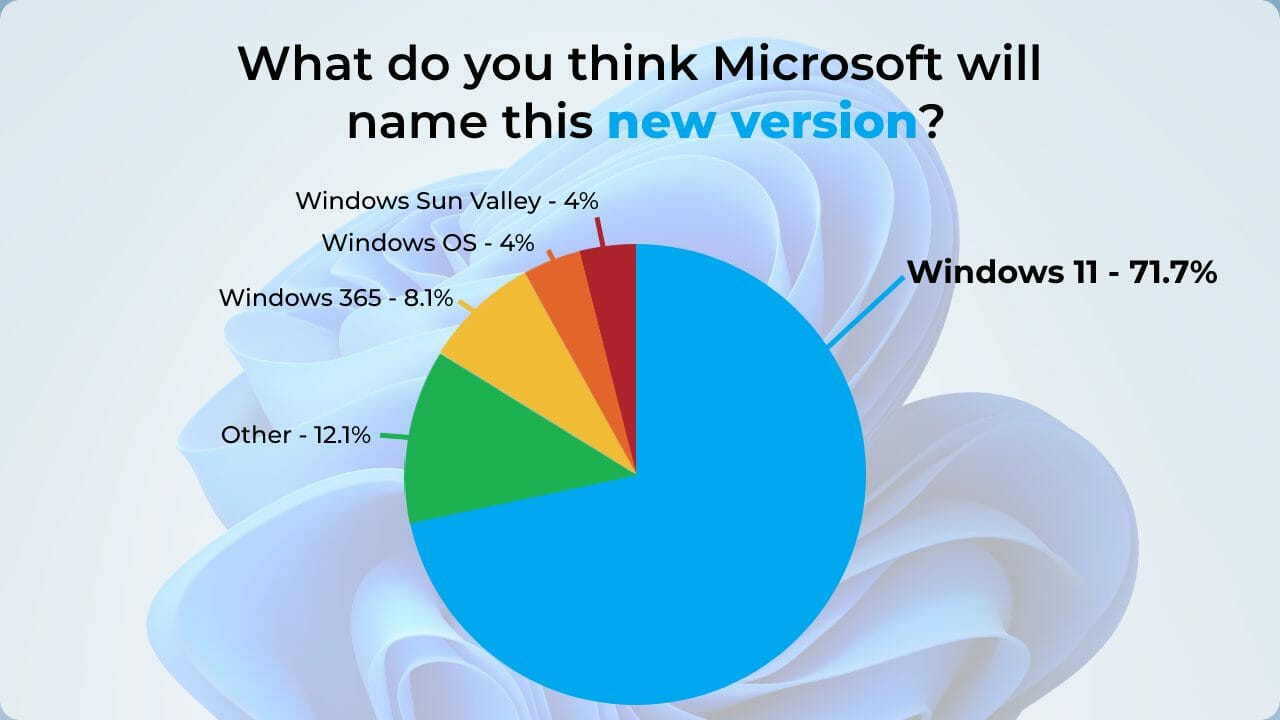
Windows 11 is the obvious name for 71% of respondents
Even though a wide range of speculations have circulated around this topic, and an even wider range of possible options have been suggested by many parties, we don’t really know yet what Windows’ new product name will be.
That said, because our team constantly researches this subject, our supposition is based on a multitude of elements, some of which you might also find convincing.
To begin with, as the big M has taken the path of naming its OSes since Windows 7 using numbers. Thus, it seems logical to continue down the same path. One potential counter-argument, though, is that Microsoft released a statement in 2015 asserting that Windows 10 is the last version of Windows (attributed to Jerry Nixon, Ignite 2015).
Since then speculations have taken flight from this idea, some have anticipated a full rebranding of the Microsoft OS to a completely different name. Others have suggested that there will be no further new versions and that Microsoft will only build upon the Windows 10 version, by patching it and offering consistent updates and upgrades.
Over recent months, a variety of situations have made people inclined to believe that a new OS from Microsoft is coming and that it will be named Windows 11. The users who participated in our survey on this topic also incline towards this idea, with 71% of them choosing this variant.
12% of the people who responded to our survey are still undecided, suggesting that Microsoft might choose a totally different name for the new release.
When it comes to the other options we presented in our survey, only 8% of users voted for the Windows 365 option, while the Windows OS and Windows Sun Valley variants have both garnered 4% of the votes.
Here at WindowsReport, we agree with the prevailing opinion of our readers. We, too, are inclined to believe that Windows 11 is the most likely choice. This assumption comes with some basis, as reported in an interesting item from this department that reveals Apple silently confirming the name choice before the actual release.
Even more tellingly, Microsoft has started a campaign against websites that leaked the Windows 11 ISO also gives clear signs that the next operating system will be called Windows 11. In fact, Microsoft’s DMCA takedown documents identify the OS using that name.
In addition, Microsoft posted an invitation to a digital event called What’s next for Windows, for June 24th on its official Twitter account. In what many observers insist is no coincidence, the event starts at 11 AM.
To fuel speculations further, the GIF used as a visual element in that post shows a redesigned Windows logo. The light shining through the window looks like the number 11. Notice the center bar from the Windows 10 logo, above, is missing in the light shining onto the surface below and in front.
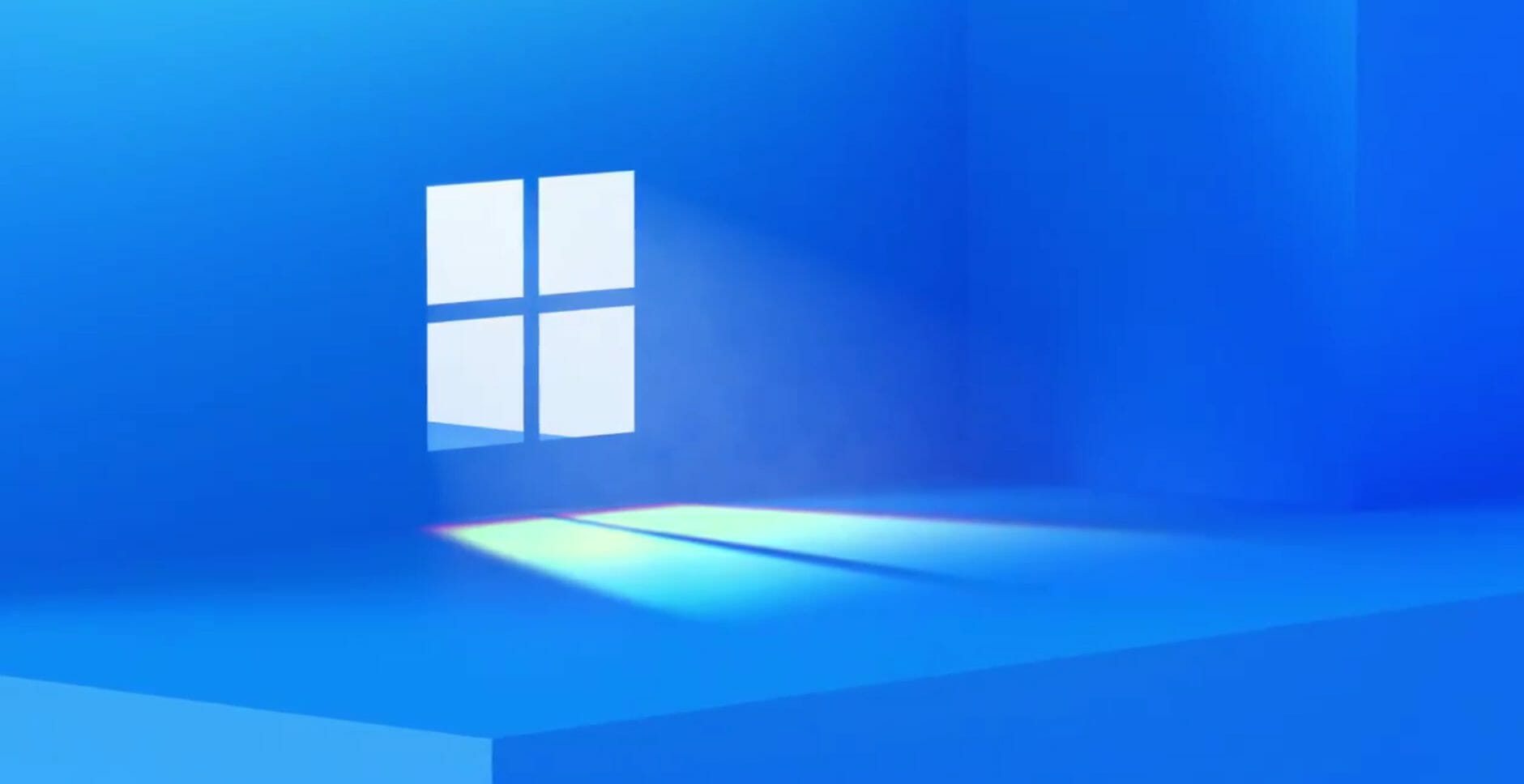
In the following text, you can see the actual post for yourself, and make your own call. Is this just a design element, or does it hint at a name for a new Windows version?
Ultimately, there is no way to know for sure what the actual name of the next Windows OS might be. We will all see its official name when the product is announced. And stay tuned, because we are going to cover that event extensively like nobody else.
Half of responders expect a completely new design & faster interface
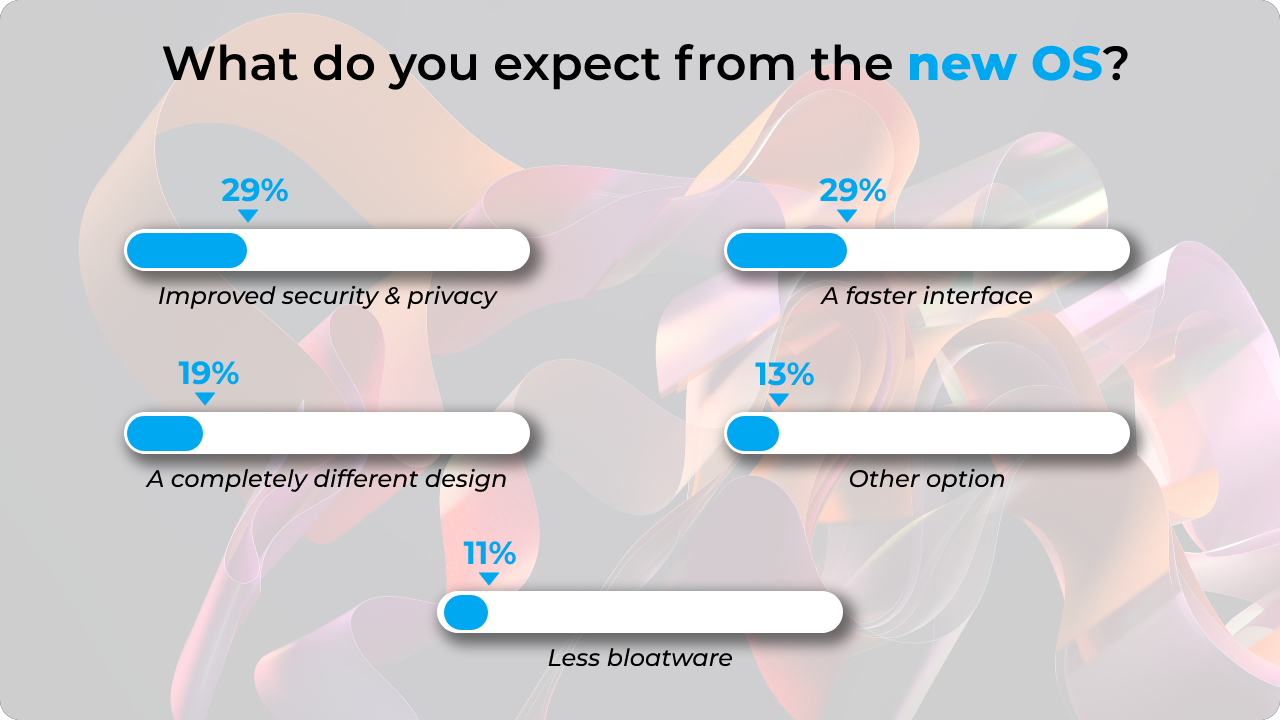
Even though Windows 10 has provided a stable-enough environment for most people, it hasn’t been without its problems either.
Ranging from issues with processing speeds even on high-end PCs, complicated design flaws, and a non-responsive interface, even though it was a lot better than its predecessors, Windows 10 and Microsoft had some serious learning to do.
Because almost half the users who took the survey expect a new design and a faster interface, we can conclude that our opinions about the need for improvements in those departments are shared by our readers.
A new design would not only make most Windows devices easier to use, it would offer a more streamlined user experience.
Speed optimization is also crucial. Looking back at Windows XP and Windows 7, Microsoft has come a long way. Could Windows 11 benefit from lessons learned over the last decade? We will surely find out soon.
29% of users anticipate enhanced security & privacy
Security and privacy features in Windows 10 have generated ample criticism. Windows telemetry has come in for adverse comment, because many users and experts believe if it isn’t modified correctly, it could gather data on users devoid of common-sense limits.
Thus it’s no surprise that 29% of survey participants anticipate an enhanced level for both privacy and security. Windows users have been bothered by this issue for a long time. Now, all hopes rest on the upcoming Windows 11 release.
While Microsoft constantly works on security improvements, backed up by its most recent updates to Edge and Windows Defender, concerns regarding user privacy still remain. With Windows 11, the tech giant wants to limit mandatory shared user data and offer individuals more control over their personal information.
This is a most welcome addition, whose value is confirmed by a third of our respondents.
Bloatware won’t bother 11% of new Windows 11 users
Surprisingly enough, it seems that only 11% of the survey participants mentioned they want less bloatware in Windows 11.
This means that contrary to prevailing opinions floating on the web, people are not that bothered by Windows 10’s pre-installed programs and software.
Some bloatware can be useful, like having a native photo viewer and other tools that are required for day to day life. That situation changes when applications for graphics design and other more specialty-oriented programs get bundled with a Windows installation.
Because most experienced Windows users are inclined to optimize their systems as much as possible, removing bloatware was not a big problem. That said, these users would favor a clean and spotless OS that allows them to directly install their own choices for software if and when they decide to do so.
Surprisingly, 26% of users won’t upgrade to Windows 11
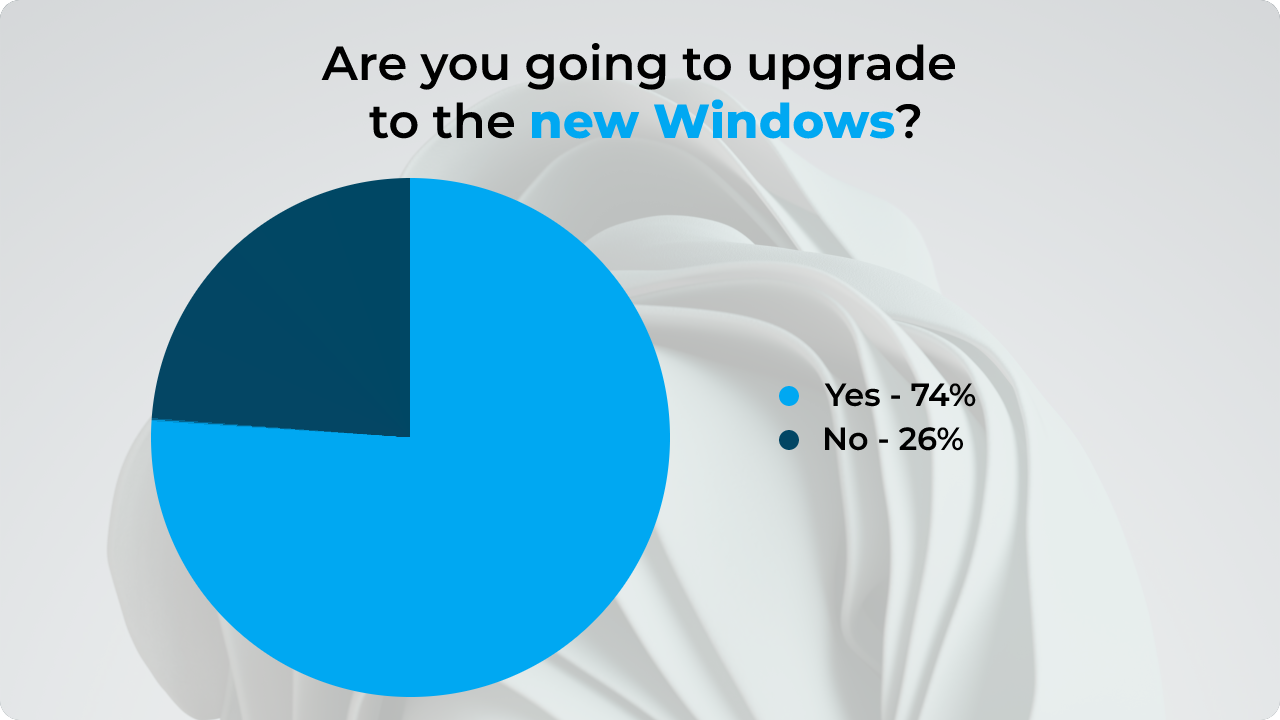
With an official unveiling for Windows 11 just around the corner, one question that laptop and PC users around the world face is whether or not to upgrade. Initially, the update and Microsoft’s event were supposed to apply only to Windows 10’s 21H2 update.
The codename Sun Valley seems to confirm that supposition. But, we do not know yet (with certainty) if these changes are just a beginning for Windows 11. Windows 10 has maintained a similar look and feel over the past few years. That’s about to change for those who are unafraid of the challenges a new Windows version can pose.
Because a quarter of the people who participated in our survey are unwilling to upgrade to Windows 11, some questions remain.
The Windows 10 experience is enough for more than a third of users
Released six years ago, Windows 10 has had an incredibly long lifespan. During this time, instead of releasing any new versions of its OS, Microsoft opted for a different strategy altogether.
This included offering regular improvements to Windows. To be more precise, it released two major feature updates (upgrades) every year – the first one in April or May and the second one in October or November.
Therefore, make no mistake – the current Windows 10 now has very little in common with the original 2015 version. Right now, Windows 10 is considered the most secure enterprise desktop OS ever and looks stylish too. Using feedback from testers and users, Microsoft has tweaked the operating system for a constantly improved and up-to-date experience.
Windows 10 has added the start button back again and this decision had a huge impact on how people received it. You already know the story by now – simply click the window icon, and you see a familiar menu. The start menu gives users immediate access to settings and power options and reveals all commonly used programs.
While the taskbar looks a lot like older Windows systems, Windows 10 also uses tiles, making it convenient to personalize your start screen. Users are free to customize them to suit their needs, just as accessing settings works like a charm.
You can easily select Settings from either the Search bar, Start menu, or Action Center, and the Settings window opens in seconds. And other examples abound with its upgraded task manager, Cortana, the voice-activated personal assistant that tells you jokes, sets reminders, or finds files for you, not to mention the Xbox app for game streaming.
From all these features to tighter security, an antivirus program, and Internet security software as part of the package, Windows 10 truly has a lot to offer. So, it comes as no surprise that 33% of users find the Windows 10 experience a pleasant one they’re not yet ready to abandon.
Data loss makes 9% say no to the upgrade
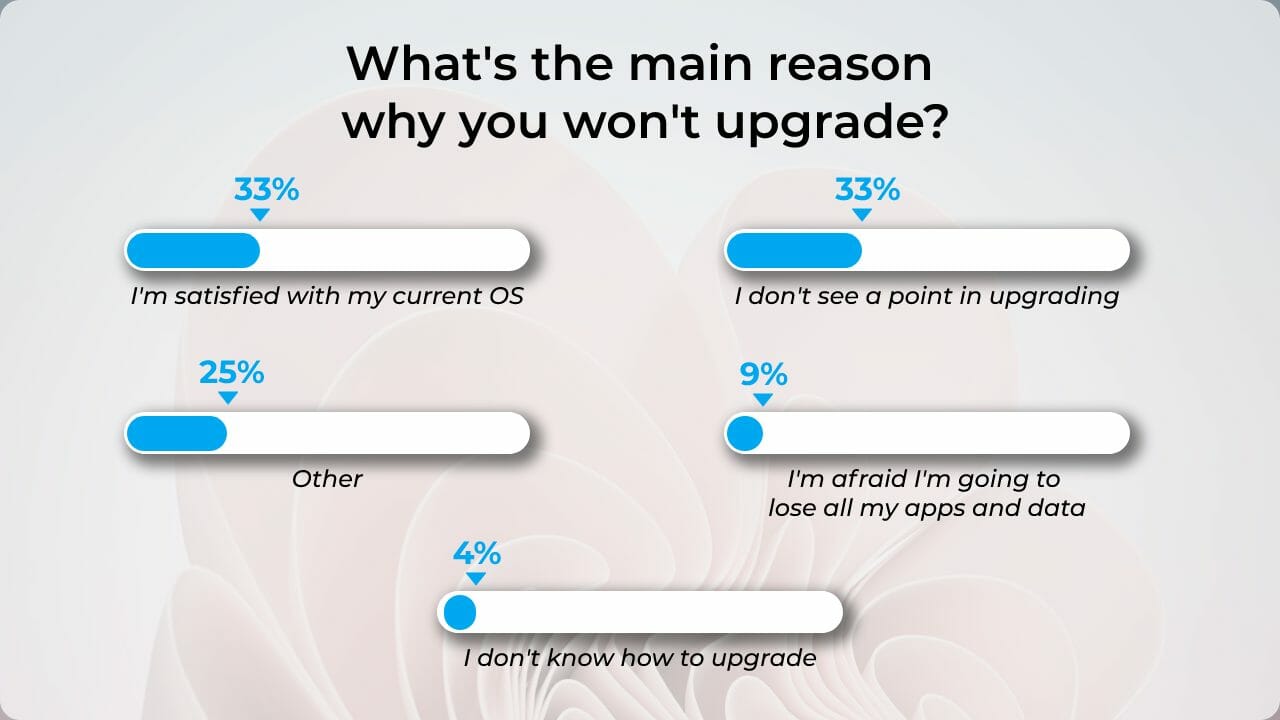
4% of the respondents declare that they don’t know how to upgrade, while a higher percentage seem afraid of the idea of losing important data.
If you’re planning to embrace the new Windows 11, then let us remind you that you can keep your data through the upgrade. This includes your documents, music files, videos, photos, Windows settings, and most of the programs you currently use.
When we’re talking about a feature update or version upgrade, chances of losing data are very close to zero. This is also the case with a fresh, clean install that also offers the option to keep all your info and files.
Furthermore, we’ve purpose-built some simple, step-by-step guides that make things easy for you both in the case of a feature update, new version upgrade, or a new install. In simple steps and terms, our guides thoroughly explain the best way to upgrade, how you can do it easily, and how to protect your data and info.
8% of users will buy a brand new device with Windows 11 preinstalled
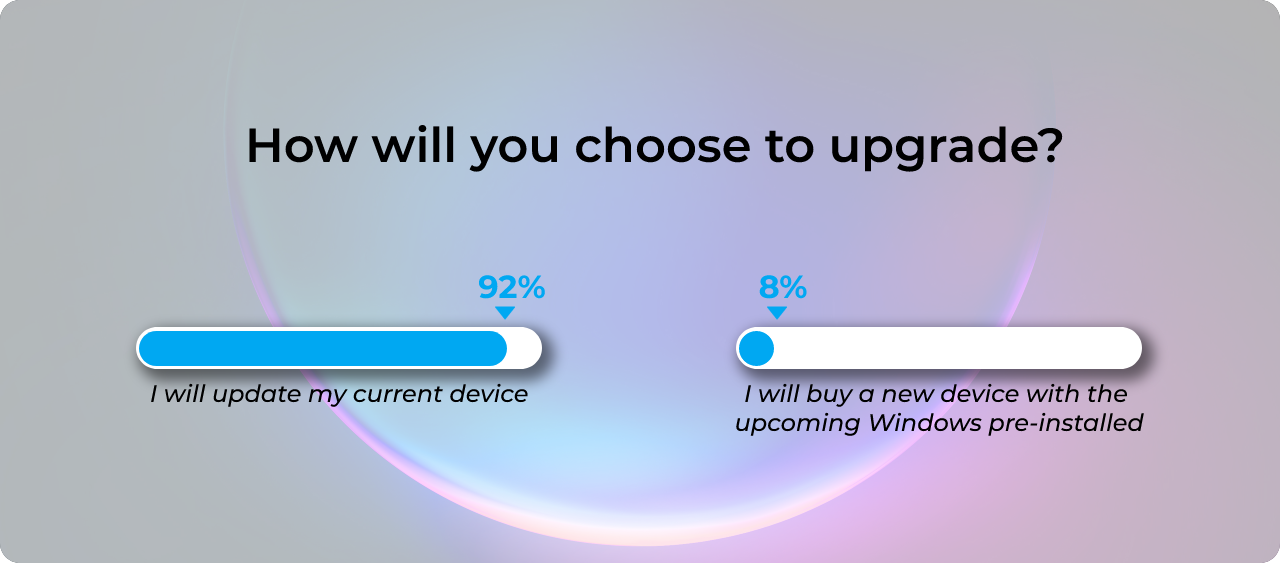
Considering that Windows 10 will reach end-of-life (EOL) in 2025, chances are that Windows 11 will come as a free upgrade for consumer devices. After all, Microsoft’s intention is to encourage the majority of Windows 10 customers to make the transition towards Windows 11 quickly.
While Microsoft is reinvesting resources in its upcoming operating system, 8% of users are ready to make an active decision as well. Some of them are eager to update their current devices to Windows 11 right away, while others intend to buy a brand new device with Windows 11 preinstalled.
The idea of Windows 11-ready devices is a great way to go. In fact, increased compatibility, top-notch optimization, and seamless integration are the primary benefits that convince people to exercise this option.
A brand new laptop is the first choice for 53% of responders
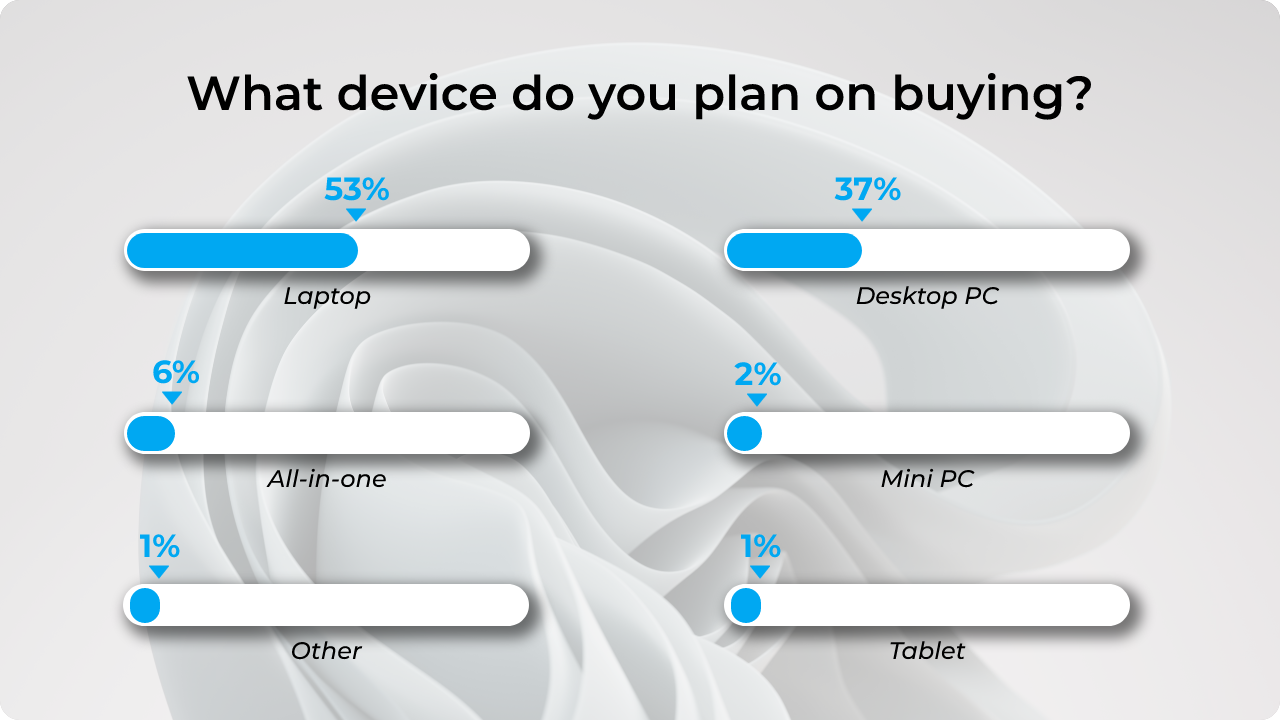
Even if Microsoft will likely offer free upgrades to all customers who own devices running on Windows 7 or Windows 10, the idea of a new laptop seems a powerful argument for no less than 53% of our respondents.
When Windows 11 arrives at scale, chances are that various hardware manufacturers will turn this into an opportunity to drive laptop sales.
A new operating system represents a huge step for the tech giant, so powerful specs would make your experience more enjoyable. There’s no better way than buying a new laptop if you’re already eager to discover the new identity for the Windows platform you use every day.
Also, the steps Microsoft is taking in the newly relevant area of hybrid work confirm market demands. When talking about the pandemic and working from home, the need for mobility and tools for home office have increased exponentially.
That’s why over half of participants in our survey willing to buy a new device want a laptop.
37% of buyers prefer a new desktop PC
Future desktop PCs are also expected to come with Windows 11 preinstalled or readily available as a free upgrade. After all, 37% of buyers prefer a new desktop PC to get the best out of this OS from the get-go.
Even if Windows 11 licenses will most likely be available for standalone purchase, nothing can match the joy of sitting in front of your new computer and enjoying a new taskbar, an innovative Start menu, and an overall fresh design.
Not only that, because more than a third of buyers are inclined to opt for a desktop PC, this means more Windows users are undertaking intensive workflows. Video editing, photo editing, 3D design and content creation are just a few of them.
Windows 11 also seems to be a compelling choice for gamers, as first benchmarks and tests show that Windows 11 handles intensive gaming a lot better than its predecessor. Increases in FPS and in smoother performance are just the first hints of what’s to come.
Windows 7 users are excited about the new OS, with 65% upgrading
Because of the bad hype that Windows 10 had with security and privacy flaws, bloatware, slow processing speeds even for powerful systems, and a plethora of errors, 65% of Windows 7 users have been waiting for a new Windows release before they’re willing to upgrade.
Their reasons vary from user to user, but we think it is safe to assume that these users have considered Windows 7 to be a more stable and reliable OS than Windows 10.
The more interesting development is that in our previous survey regarding Windows 7 and the willingness of users to upgrade to Windows 10, the majority of them weren’t ready to change their OS. Now, almost two-thirds of our Windows 7 responders are determined to change it, which is great news for Microsoft.
16% of Windows 7 users will buy a new Windows 11 device, double the amount of Windows 10 users
From our thorough survey, we can see that 16% of Windows 7 users will also consider investing in a new Windows 11-enabled device, which is double the amount compared to Windows 10 users.
This statistical result makes sense from the perspective that Windows 7 users didn’t even consider investing in a new device, as the OS was optimized for the device they already owned.
Now, with Windows 11 sounding so promising, and Windows 7 well into its second decade, a wider range of users are ready to invest in a device that should deliver better workflows in the new OS.
The majority of Windows 7 users will buy a Windows 11 desktop PC
Even though the popularity of laptops has not decreased in the last years, our study shows that 51% of the Windows 7 users will invest their hard-earned money into a Windows 11 desktop PC, not in a portable device.
Being able to carry your laptop everywhere with you can be helpful in some situations, but when it comes to raw power and the extensibility or expandability, desktops are always more capable and reliable.
This also suggests that enterprises are thinking about refreshing their workstations. Considering that Windows 11 is a brand new OS, the potential lifetime of a new system is at least a decade. This is the perfect incentive for small, medium, and large businesses to make the upgrade.
Our own conclusion about Windows 11
With Microsoft’s big event just around the corner, we’ll soon find out with certainty if our expectations will be met or disappointed. For now, it’s nearly certain that we’ll have a complete redesign, better performance, and a smoother interface.
That the new OS will be named Windows 11 is also pretty much confirmed.
In the near future, we’re expecting a new wave of Windows 11-ready devices tailored for a seamless experience and top-notch performance. And, as hinted by Microsoft’s new design changes, these devices are not only laptops and PCs, but also mobile devices with multiple screens.
Productivity is the name of the game, and the big M is ready to throw in its newest player.
If some of the things revealed by our thorough analysis seem a bit surprising, that’s because they are. As in the online world, user behavior is constantly changing, hopefully for the best.
If you want to learn more about what’s to come, be sure to check our full coverage. Also, join us for the official unveiling to be part of the first community with access to the latest news and guides about Windows 11. Don’t forget to subscribe to our newsletter and we’ll be sure to set up a reminder so you won’t miss the event.
About the data

The research above was constructed based on the input of our readers through an online-survey which ran for a week on WindowsReport.com. Using Crowdsignal, a popular survey tool, we have gathered 6056 complete answers on all of our questions.
With a completion rate of 73%, we also had 2288 incomplete surveys, which were not included in the research above. We took the decision to include only data that was completely accurate and final, thus taking into consideration only readers that have answered all of our questions.
We’ve received answers from 152 countries, but the most popular locations were:

- United States of America – 31.7%
- India – 14.2%
- United Kingdom – 8.3%
- Canada – 4.85%
- Australia – 4.14%
When it comes to platform distribution, readers that have completed this survey are mainly using Windows 10. We’ve also recorded answers from people that are using Windows 7, macOS, Linux or Chrome OS.

The raw-data used in the research above can be seen and downloaded here.
Our researchers
Passionate about technology, Windows and everything that has a power button, Vlad is the chief editor of WindowsReport.com. With a keen eye for fact-checking, Vlad is a constant watcher over the Windows world and all that surrounds it.
Author of over 140 computer trade books, including 60-plus titles on various certification topics, developer of over 70 online and classroom courses, Ed Tittel is an expert consultant on information security, markup languages, web development and networking technologies.
